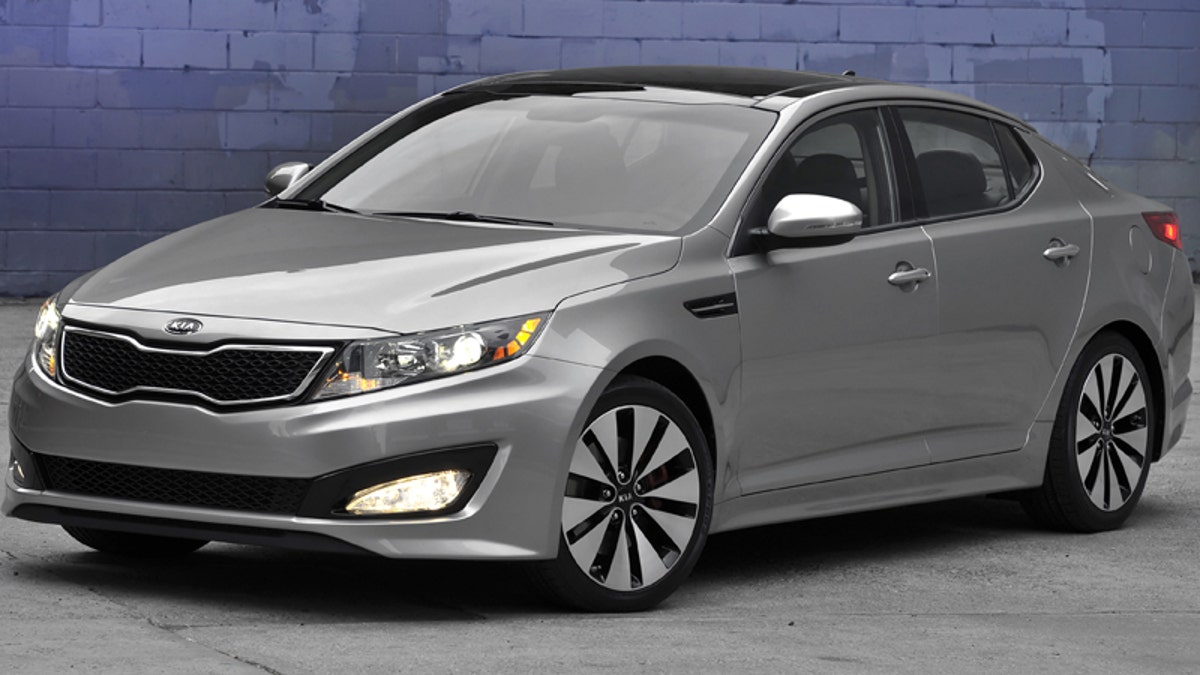
(Kia)
Car wash employees know cars. They literally get down and dirty with dozens every day. Caressing them with their hands, digging deep into all of their nooks and crannies…it’s a very up close and personal relationship, like being a masseuse.
And, as is the case with a masseuse, it takes a lot to impress these guys and gals. I’ve never seen a car do it as well as the 2011 Kia Optima.
Passing through the stations of the hand wash outlet on my test drive route, the sleek, black sedan picked up followers like Rocky jogging through the streets of Philadelphia. I don’t understand Spanish too well, but when you hear “Kia” and “Dios mio” in the same sentence, it’s got to be good. By the time I pulled away, the entire shop was lined up at the exit like some soapy, waxy-handed honor guard. Man, I hope I tipped them well.
Almost inconceivably, the new Optima is simply the most-striking mainstream sedan in America. I’m sorry to have to tell you that, but take a good look at its Jaguar-meets-Germany design, go to your window and be honest with yourself about that Toyota Camry or Ford Fusion parked in the driveway. Nice, but next to the Optima they are like blazers and khakis in James Bond’s closet.
Belying its rather large midsize stance, the Optima is only available with four cylinder engines, an apparent sacrifice at the altar of fuel efficiency. But they don’t make you suffer. The standard engine is a 200 hp, 2.4-liter, while 274 hp 2.0-liter turbo models are also available. Six-speed manual and automatic transmissions feature in the mix, and even a hybrid model is on the way.
If these specifications sound familiar to you, it’s because under they are the basically the same as those of the hot-selling Sonata from Hyundai, Kia’s sister company. Mechanically, the two cars are identical. It’s in the details that they differ.
As with the Sonata, the Kia is covered by an epic 10 year/100,000 warranty, and even the most basic versions come standard with satellite radio, USB and Bluetooth, but its $19,690 starting price is about $500 cheaper than the Sonata’s.
The interiors of the two are as distinct as their exteriors, and the Kia is a winner here, too. Its cockpit-style dashboard is straight out of the European luxury sedan playbook, and finished in soft, stitched materials. The Sonata’s was impressive until this came along, but its plain, hard surfaces can’t compete. Chalk it up to the still bargain basement cost of building a car in Korea, where the Optima is made, rather than the Sonata’s hometown of Montgomery, Alabama. Clearly the savings were spent well.
Step up through various trim levels and you can load the Optima with goodies like a very solid infotainment system with 360 watts worth of Infinity audio, heated and cooled front buckets and even heated outboard rears. Not a common sight in this class and a reflection of how often they will be used, thanks to full-size levels of legroom. The cabin is gargantuan. Icing for this tasty cake is a dual-pane, panoramic sunroof that turns the car into a veritable greenhouse.
Along with plenty of oomph, the Optima’s engines deliver serious fuel economy. Thirty-five miles per gallon highway for the base model, and 34 mpg for the turbo – this in a car with more power than a BMW 528i. Direct fuel injection is the key, high-tech stuff that most of its competitors can’t afford.
It’s also a tough technology to work with and can make a motor a little noisy, as it seems to do here. Nothing to get bothered about, but since the car is otherwise so quiet it’s one of those things that you notice.
Luckily, the same goes for the power. Regardless of which engine you choose, the Optima steps off with enough gusto to spin the front tires and send a good amount of torque steer through the steering column. A more sophisticated suspension would help to quell the latter, but, as it stands, the Optima’s is nicer than the Sonatas. It’s more compliant, more comfortable and, even if it is not up to the dynamic challenges that the engines put forth, makes for a nice boulevardier.
That said, unless you are truly power hungry, or live at the kind of high altitudes where the air is thin and forced induction comes in handy, you can easily live without the turbo, though the extra kick is nice when dicing through traffic. But, at a premium of just $2,000 more than a similarly-equipped 2.4-liter model, it’s not exactly the world’s most expensive indulgence. Plus, it has paddle shifters and rides on some pretty sharp Hot Wheels-style flush alloy rims that it wears like spats with a tuxedo. Sassy.
The only real beef I have with the Optima is the steering. It’s quick to respond to inputs, but manages to be at once heavy and vague, with an annoying tug back to center like it has a bungee cord attached to the bottom of the wheel. Both of the cars that I drove also pulled slightly to the left. Constant corrections were necessary and near the end of a very long drive in the turbo I started to get the jimmy-arms, but not so bad as to take the shine off of the Optima.
Nevertheless, Hyundai will sell many more Sonatas than Kia will Optimas, thanks in part to a larger, stronger dealer network. This shouldn’t be. The mother ship is a fine car, but the Optima is better, more attractive and comes at a slightly more appealing price.
You can use leftovers to give bigger tips.
-----
2011 Kia Optima/Optima Turbo
Base Price: $19,690/$25,190
Type: 5-passenger, 4-door sedan
Engine: 2.4L inline-4/2.0L turbocharged inline-4
Power: 200 hp, 186 lb-ft torque/274 hp, 269 lb-ft torque
Transmission: 6-speed manual or automatic/6-speed automatic
MPG: 24 city, 35/34 hwy (man/auto)/22 city, 34 hwy